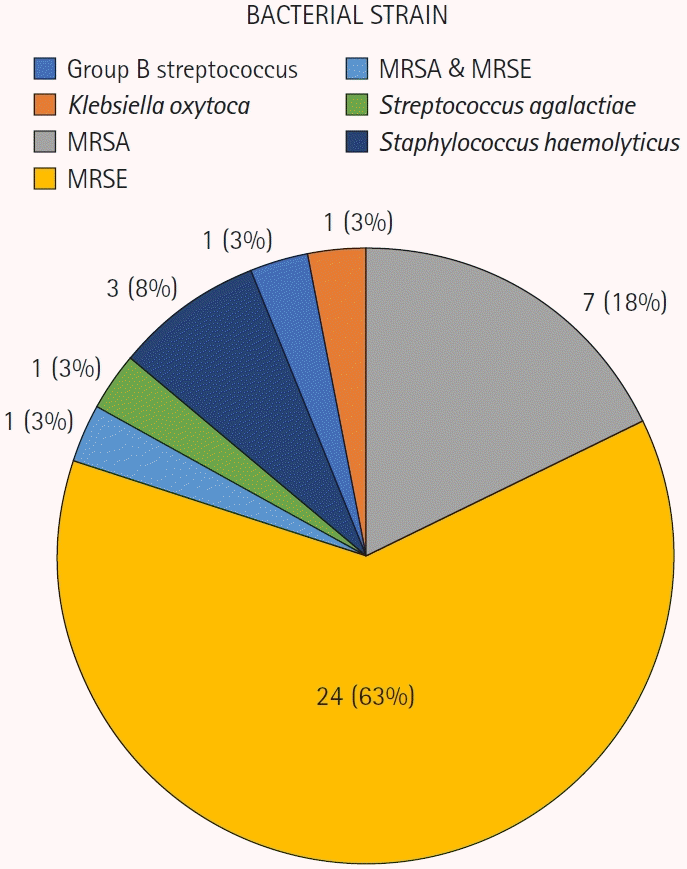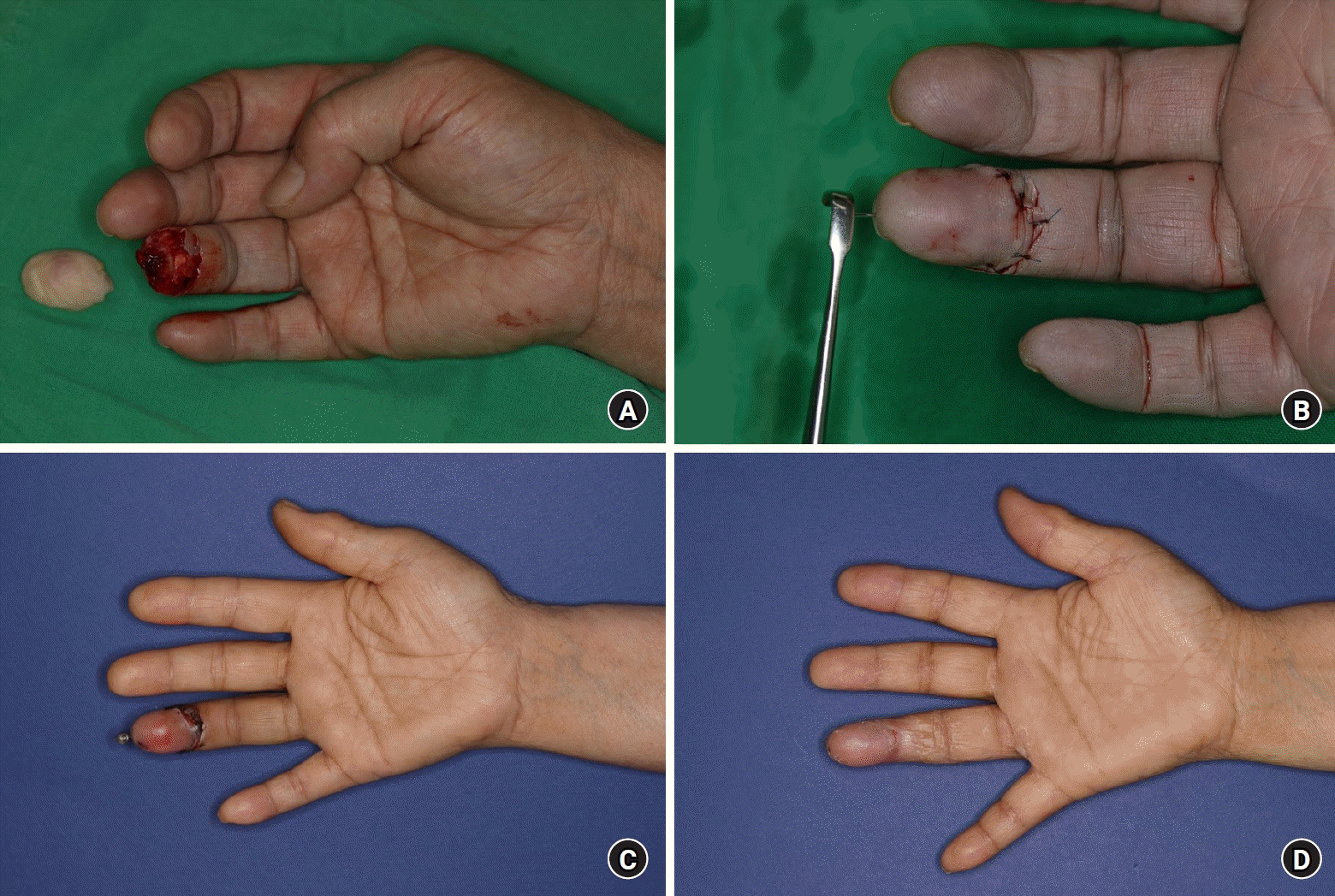1. Sebastin SJ, Chung KC. A systematic review of the outcomes of replantation of distal digital amputation. Plast Reconstr Surg. 2011; 128:723–37.

2. Komatsu S, Tamai S. Successful replantation of a completely cut-off thumb. Plast Reconst Surg. 1968; 42:374–7.

3. Yamano Y. Replantation of the amputated distal part of the fingers. J Hand Surg Am. 1985; 10:211–8.

4. Buntic RF, Brooks D. Standardized protocol for artery-only fingertip replantation. J Hand Surg Am. 2010; 35:1491–6.

5. Chen KK, Hsieh TY, Chang KP. Tamai zone I fingertip replantation: is external bleeding obligatory for survival of artery anastomosis-only replanted digits? Microsurgery. 2014; 34:535–9.

6. Barnett GR, Taylor GI, Mutimer KL. The "chemical leech": intra-replant subcutaneous heparin as an alternative to venous anastomosis. Report of three cases. Br J Plast Surg. 1989; 42:556–8.

7. Foucher G, Norris RW. Distal and very distal digital replantations. Br J Plast Surg. 1992; 45:199–203.

8. Kim SW, Han HH, Jung SN. Use of the mechanical leech for successful zone I replantation. ScientificWorldJournal. 2014; 2014:105234.

9. Lee NH, Yang KM. The problem of leech application in digital replantation. J Korean Soc Surg Hand. 2000; 9:158–63.
10. Busing KH, Doll W, Freytag K. Bacterial flora of the medicinal leech. Arch Mikrobiol. 1953; 19:52–86.
11. Daane S, Zamora S, Rockwell WB. Clinical use of leeches in reconstructive surgery. Am J Orthop (Belle Mead NJ). 1997; 26:528–32.
12. Prsic A, Friedrich JB. Postoperative management and rehabilitation of the replanted or revascularized digit. Hand Clin. 2019; 35:221–9.

13. Boulas HJ. Amputations of the fingers and hand: indications for replantation. J Am Acad Orthop Surg. 1998; 6:100–5.
14. Hong MK, Park J, Koh SH, et al. Analysis of outcomes of Tamai zone I digital replantation in cases of severe crushing injury. Arch Hand Microsurg. 2020; 25:297–303.
15. Hattori Y, Doi K, Ikeda K, Abe Y, Dhawan V. Significance of venous anastomosis in fingertip replantation. Plast Reconstr Surg. 2003; 111:1151–8.
16. Efanov JI, Rizis D, Landes G, Bou-Merhi J, Harris PG, Danino MA. Impact of the number of veins repaired in short-term digital replantation survival rate. J Plast Reconstr Aesthet Surg. 2016; 69:640–5.
17. Ryu DH, Roh SY, Kim JS, Lee DC, Lee KJ. Multiple venous anastomoses decrease the need for intensive postoperative management in tamai zone I replantations. Arch Plast Surg. 2018; 45:58–61.

18. Han SK, Lee BI, Kim WK. Topical and systemic anticoagulation in the treatment of absent or compromised venous outflow in replanted fingertips. J Hand Surg Am. 2000; 25:659–67.

19. Foucher G, Merle M, Braun JB. Distal digital replantation-one of the best indications for microsurgery. Int J Microsurg. 1981; 3:263–70.
20. Whitlock MR, O'Hare PM, Sanders R, Morrow NC. The medicinal leech and its use in plastic surgery: a possible cause for infection. Br J Plast Surg. 1983; 36:240–4.

21. Mercer NS, Beere DM, Bornemisza AJ, Thomas P. Medical leeches as sources of wound infection. Br Med J (Clin Res Ed). 1987; 294:937.

22. Tepas JJ. Editor's foreword. J Trauma Acute Care Surg. 2012; 73:S235.

23. Tran PA, O'Brien-Simpson N, Palmer JA, et al. Selenium nanoparticles as anti-infective implant coatings for trauma orthopedics against methicillin-resistant Staphylococcus aureus and epidermidis: in vitro and in vivo assessment. Int J Nanomedicine. 2019; 14:4613–24.
24. Hospenthal DR, Murray CK, Andersen RC, et al. Guidelines for the prevention of infection after combat-related injuries. J Trauma. 2008; 64(3 Suppl):S211–20.
25. Haque N, Bari MS, Haque N, et al. Methicillin resistant Staphylococcus epidermidis. Mymensingh Med J. 2011; 20:326–31.
26. Kalani BS, Khodaei F, Moghadampour M, et al. TRs analysis revealed Staphylococcus epidermidis transmission among patients and hospital. Ann Ig. 2019; 31:52–61.
27. Inweregbu K, Dave J, Pittard A. Nosocomial infections. Cont Educ Anaesth Crit Care Pain Med. 2005; 5:14–7.

28. Ziebuhr W, Hennig S, Eckart M, Kränzler H, Batzilla C, Kozitskaya S. Nosocomial infections by Staphylococcus epidermidis: how a commensal bacterium turns into a pathogen. Int J Antimicrob Agents. 2006; 28 Suppl 1:S14–20.






 PDF
PDF Citation
Citation Print
Print






 XML Download
XML Download